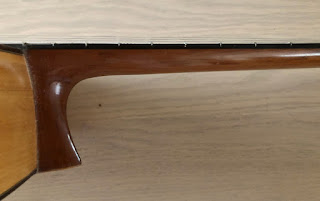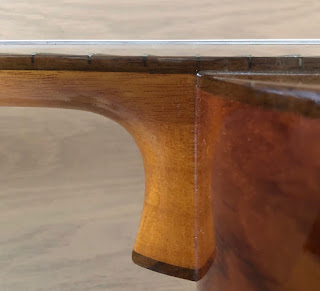
Close to the city of Sevilla Manuel Romero Macias and
his son are building guitars in the traditional way. This
builder is merely focused on sound and his guitars are
really responsive, lightly built with a certain kind of
percussive quality. Good balance and ease of playing.
He pays less attention to all the details in guitar-
building but nevertheless his instruments are worth
to go for. This example of a handbuilt flamenco guitar
is very nicely priced, due to some imperfections that
will be explained further on. Price: 750 Euro.
Macias uses premium grade materials of which my
classical model attests. You can take a look on youtube
to have a close listening to this classical model from
1995. He used Brasilian rosewood for sides and back
and mounted the top of the line damascening treated
Fustero tuners, a proces where a layer of gold is used
against the black metal base plates. The flamenco
guitars, Sevilla is known for, can be judged by listening
to the sound example on the site of Vintage guitar world.
They're selling there a 2005 Flamenco guitar executed
in maple in combination with a cedar top surprisingly.
But the price there is 1950 Euro's.
The way he shapes the heels for example is very gracefully.
Remarkable is the neck that exist of two halves seperated by an
inlay all the way up to the head of the guitar. In order to make
it possible to mount thinner shaped necks which enhances
the playability.
The topnut has been changed as there is some
evidence of the sloppyness that can be found
here and there on his instruments. No big deal
however to have that properly done. Same thing
counts for the fret work and especially the fret
ends.Width topnut is 53 mm. Scale 650 mm.
Nice low action with enough bridgebone and this
is the "good" side of this guitar.
His label stayed very simply during all the years he was active.
Now his son is in charge and still builts in Montellano.
A double "see through" scratchplate and a
nice rosette. Ebony fingerboard in good shape.
One well repaired crack in the soundboard.
On the other side a roughly repaired crack is still visible.
And that is often the problem with cypress: It cracks
quite easily. But thoughts are that this guitar accidentely
fell on the floor, thus causing some damage. Well repaired
so it doesn't has any influence on the sound of the guitar
but it certainly makes its' price more agreable! Here the
outer part of this side still has to be done.
In fact not even an insert in the lower bout as that wasn't needed.
Alass the discolouration is there but it does not influnence the
sound. The soundboard has a slight downward curve between
bridge and soundhole. That has everything to do with the
fact that Romero Macias keeps his soundboards absolutely
straight while with most luthiers the sounboard is slightly
curved. That adds stability but also stiffness to the top and
that is something you do not want that much: You want
the top to vibrate freely.
This is the formerly damaged side but it has been repaired in
Spain in the past and is stable during the 10 years I owed this
guitar. I only did some cosmetic work on the outer part.
Not nice to look at but stable as has been stated. For
cosmetical reasons one could have this side veneered.
A straight neck and fairly flat which enhances playability
to my believe. A thin layer of ebony for the fingerboard
in order not to make the neck too heavy.
Newly added tuners which work very well.
The strange move Manuel Romero always makes.
Two halves of wood for the neck up into the head.
Just click on this picture to be able to study it.
Ad the back which is in a very reasonable condition.
Some more information from Vintage guitar world:
Manuel Romero – a flamenco guitar with a huge punch and a great dynamic!
Manuel Romero Macias is a Sevilla based luthier. The workshop is in Montellana (near Sevilla).
His guitars fall into a special category. They are true hand made instruments, built by an old-school luthier using the finest materials. They possess a wonderful sound, and are very affordable. This guitar (2005 Flamenco model Vintage guitar world) has a cedar top and a maple body – a rare and spectacular combination. The scale length is 660 mm and the nut width 52 mm.
The tone of this particular instrument is sweet, beautiful and lyrical while retaining the bite and energy of flamenco: when playing melodically, it sings like a human voice, but also awakens with a tremendous bite when pushed hard. The strong, voice-like trebles are balanced by it’s big low-end that is full but not boomy. As sweet as the tone is, it still has the aggressive response when pushed in the right direction – rasguedos in particular are quite explosive and powerful.
The setup is very comfortable and the guitar plays with great ease. A great chance to get a high quality handmade guitar at an affordable price. USD 1950,-
Antonio Mateu Ramis
Antonio Mateu Ramis was a Barcelona based luthier.
Little can be found about his activities but a classical
guitar by this builder was highly praised by the famous
Alexandre Lagoya. (Collection Sebastian Stenzel)
Very lightly built in the typical flamenco tradition.
Spruce top and ebony fingerboard.
A dry tone and quickly responding.

Apart from the nice Rosette you can see the double
scratchplates as is common on flamenco models.

On this label the luthier marked this instrument no. 13 being
dated the first of july 1953. In fact this luthier stopped in about
1965. He had no successors. A classical guitar of this builder
is in the possesion of Sebastian Stenzel . (no. 239 - 1961)

The back of this guitar wasn't free from cracks either
but the damage could be easily cured and finished.

On this guitar the use of cypress can be clearly seen.
This is still tradition in flamenco guitar building though
it is possible to order a "negro" flamenco model
that has been equipped with a rosewood back.
Ebony tuning pegs to lighten the guitar in fact
isn't the right solution but at the same time
proof for a certain kind of quality.





























































